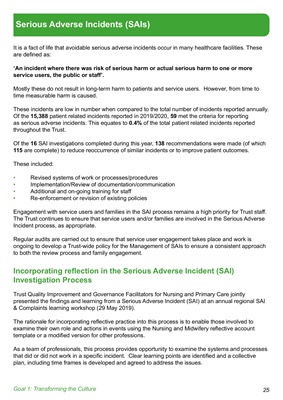
Serious Adverse Incidents (SAIs)
It is a fact of life that avoidable serious adverse incidents occur in many healthcare facilities. These
are defined as:
'An incident where there was risk of serious harm or actual serious harm to one or more
service users, the public or staff'.
Mostly these do not result in long-term harm to patients and service users. However, from time to
time measurable harm is caused.
These incidents are low in number when compared to the total number of incidents reported annually.
Of the 15,388 patient related incidents reported in 2019/2020, 59 met the criteria for reporting
as serious adverse incidents. This equates to 0.4% of the total patient related incidents reported
throughout the Trust.
Of the 16 SAI investigations completed during this year, 138 recommendations were made (of which
115 are complete) to reduce reoccurrence of similar incidents or to improve patient outcomes.
These included:
• Revised systems of work or processes/procedures
• Implementation/Review of documentation/communication
• Additional and on-going training for staff
• Re-enforcement or revision of existing policies
Engagement with service users and families in the SAI process remains a high priority for Trust staff.
The Trust continues to ensure that service users and/or families are involved in the Serious Adverse
Incident process, as appropriate.
Regular audits are carried out to ensure that service user engagement takes place and work is
ongoing to develop a Trust-wide policy for the Management of SAIs to ensure a consistent approach
to both the review process and family engagement.
Incorporating reflection in the Serious Adverse Incident (SAI)
Investigation Process
Trust Quality Improvement and Governance Facilitators for Nursing and Primary Care jointly
presented the findings and learning from a Serious Adverse Incident (SAI) at an annual regional SAI
& Complaints learning workshop (29 May 2019).
The rationale for incorporating reflective practice into this process is to enable those involved to
examine their own role and actions in events using the Nursing and Midwifery reflective account
template or a modified version for other professions.
As a team of professionals, this process provides opportunity to examine the systems and processes
that did or did not work in a specific incident. Clear learning points are identified and a collective
plan, including time frames is developed and agreed to address the issues.
Goal 1: Transforming the Culture 25